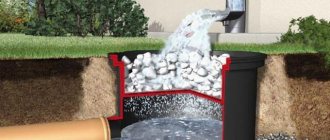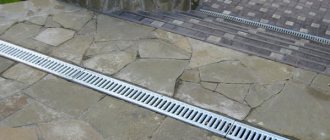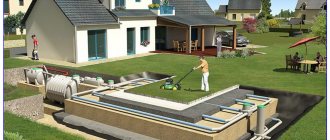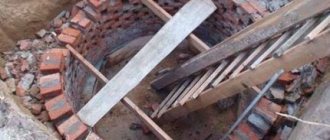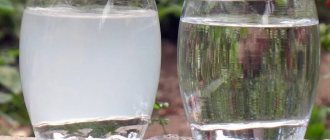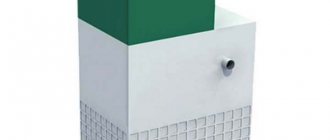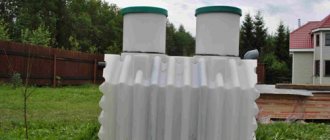In this article:
- Determination of storm drainage on the road
- Types of storm drains
- Storm drainage system on the road
- Treatment facilities for storm drainage on the road
- Nuances of designing storm drainage on the road
Storm drainage on a road is a whole system that not only collects and removes excess water from the roadway, but can also carry out its primary purification. The composition of water on a highway may be completely different than somewhere in the private sector.
Taking these features into account, when designing a storm drain on a road, it is necessary to use regulatory documents that regulate its parameters. In our article we will talk about the main differences of such a storm drain, present the legal requirements and consider the features of its construction.
Determination of storm drainage on the road
A storm drain on a road is an engineering structure that provides drainage of rain and melt water from highways, municipal sites and private areas. Stormwater systems carry water that falls in the form of precipitation into drains, sewers, and various bodies of water.
Storm gutters, inspection wells, storm water inlets, sand traps, collectors, sewer pipes - all this is included in a complex storm sewer system. All its elements are closely interconnected and are extremely important for smooth operation.
The effectiveness of stormwater drainage systems depends on how thoroughly the project was thought out and developed. The design documentation must take into account all important points. Especially such factors as: pollution associated with the functioning of enterprises, gas stations and industrial facilities. The presence of conditions that have a negative impact on the environmental situation requires the mandatory installation of treatment equipment.
Plastic drainage trays, concrete from the manufacturer
Our company is the official representative of the world leader in the production of drainage trays made of plastic, concrete, polymer concrete, polymer sand - the Russian brand Gidrolika! At the moment, you can buy from us trays with cast iron, plastic, galvanized steel and stainless steel gratings, sand traps, storm water inlets, drainage pipes, sewer hatches, in a word, everything you need for arranging and installing a high-quality water drainage system on the site.
Distinctive features of drainage trays
Concrete, plastic, polymer concrete and polymer sand trays are produced in standard versions for urban infrastructure, suburban construction, greenhouses and farms, industrial enterprises and the agricultural complex.
Products are provided for systems operating under heavy load conditions - in areas with high traffic density of vehicles and heavy vehicles.
The use of the latest materials allows our company to offer products that surpass concrete in basic characteristics:
- strength,
- frost resistance;
- durability;
- resistance to shock loads and environmental influences,
- inertness to chemical reagents;
- weight (when using polymers - several times superior).
Design and high accuracy of geometric dimensions are the characteristics of trays, which, along with the quality of materials, have a decisive influence on the speed of installation and the amount of costs for repairs and maintenance during operation.
We work directly from the manufacturer, and the enterprise (manufacturing plant) produces all the necessary components and elements of drainage systems (trays, protective gratings, sand traps, drainage wells, drainage pipes, etc.) in combination with a wide range of materials for strengthening and protection soil.
The entire complex can be ordered in one place and significantly save not only on the total cost, but also on the time when organizing delivery.
We are the official representative of the manufacturer of drainage systems
Our company is a reliable supplier with an impeccable reputation. Well-established and well-established supply chains and professionalism of employees ensure:
- timely execution of orders;
- accuracy of selection and packaging in accordance with the specialization and field of activity of clients.
Design developments are carried out on individual orders. We help you plan the best option for placing drainage trays on your site, taking into account all the features of the surface, slope, groundwater table, level of seasonal precipitation and other characteristics.
Types of storm drains
Experts distinguish three main types of stormwater systems: open, closed and mixed (they differ in the way the collected sedimentary water enters the stormwater drain). When designing, arranging and assembling such systems, it is important to take into account the operating principle of each of them.
- Open drainage
This type of storm drain is a complex of trays, gutters and other elements that ensure the flow of sedimentary water into the soil or a specially designated place. Since an open stormwater system is the most economical, it is most often used in private homes, but it has one drawback - it freezes.When designing this type of structure for collecting sediment water, it is important to correctly calculate the installation height of the drain elbow. It is necessary to ensure that in the future it is possible to clean the storm water inlet. Paving slabs or asphalt covering are laid with a slope towards the drainage tray, but 3-4 mm higher than it. The water then goes into the sewer. When calculating the slope, the landscape features of the area from which water will be collected are taken into account.
- Closed underground storm drain
In this case we are talking about a more complex system that is below the zero point. To lay it, it is necessary to carry out earthworks. Installation and design of underground drainage systems, unlike open storm drains, must be carried out by a qualified specialist. This system is used in urban environments and industrial areas where large volumes of heavily polluted wastewater are present. Such wastewater requires preliminary treatment before it enters the soil or water bodies.A closed underground drainage system is laid using a sand cushion, which makes it easier to plan the required slope. The pipes through which water passes into the collector are buried in the ground with a slope of 3 cm for every meter relative to the storage well.
This is interesting!
“How to design storm drains”
More details
- Mixed type
For large areas, a mixed type of storm drainage is used, which includes separate elements of an open and closed system. This option makes it possible to reduce installation costs in comparison with underground systems, while all sanitary and hygienic standards are taken into account. Mixed storm sewers make it possible to collect runoff from large areas.
Plastic drainage tray with grid
At any time of the year, local areas, as well as the streets of modern cities, require the adoption of effective solutions that prevent the formation of dampness, puddles and stagnant water.
Otherwise, these processes not only have a bad effect on the appearance of buildings and structures, but also significantly worsen their performance characteristics, reducing their service life. A plastic drainage tray with a grate from , will allow you to collect rainwater on the territory in an organized and quick manner.
In addition, they can be used in industrial enterprises to collect relatively pure substances that are formed during the production process.
Depending on the type of terrain, drainage systems can be implemented in one of the following ways:
- mixed storm drainage - a combined system in which linear drainage alternates with point drainage;
- “Storm drains” of the point type require large financial costs, as well as a significant amount of excavation work. The structure is a collection of storm water inlets united by a system of sewer pipes. Mainly used in areas with simple terrain;
- linear storm drains are the most economical and simple option for protecting buildings. Suitable for hilly and flat areas, where storm drains (gutters, gutters) can be easily laid. In addition to trays, the system includes check valves, waste collection baskets, sand traps, plugs, clamps and other additional elements.
Installation of drainage trays is a very responsible operation. After all, the surface drainage system is laid in pre-formed soil, which contains fertile soil and sandy loam. That is, you can’t count on great support capacity.
In addition, such soil freezes to a depth of more than one meter, so the supporting part of the tray will also be affected by frost heaving (a consequence of the expansion of soil moisture during the ice-water phase transition and decompaction of the soil skeleton).
Advantages of our company
- The lowest prices for drainage systems. There are individual discount systems for wholesalers.
- High speed of delivery and order processing. You don't have to wait long! Thanks to the excellent qualifications of our staff, you will receive the goods in the shortest possible time.
- The highest quality products. All products, without exception, are certified.
To purchase a plastic drainage tray with a grate in the Moscow Region and Moscow, just leave a request on the website of our online store “Drainage Shop”. We work seven days a week, so you can pick up purchased parts for storm drainage at any convenient time, or order delivery. We guarantee excellent quality at an affordable price.
Storm drainage system on the road
Groundwater, accumulating in the upper layers of the earth at low temperatures, freezes, expands and damages the road surface. They are a serious destructive factor. Over time, additional moisture enters the resulting cracks, which seeps into the soil, accelerating the destruction process.
Large accumulations of water on the roads often become the cause of traffic accidents, as the adhesion of the wheels to the road surface is disrupted and the vehicle becomes uncontrollable (hydroplaning effect). In conditions of dense city traffic, this is especially dangerous, as it poses a threat to life for drivers and pedestrians.
The entire storm drainage system is installed on the side of the road or under the road surface. It includes special gutters and edge trays.
To ensure more efficient drainage of water, the road surface is laid with a slope (one-sided or two-sided) towards the side of the road. In case this road is one-way, a one-way slope is used. On a multi-lane highway, a slope is designed in both directions, due to which the water flows through the gutters to the storm grates. The wastewater is directed through the edge trays to the discharge points.
If necessary, a special slope is designed. On roads with a large number of lanes, receiving trays are installed in the center, connected to edge gutters using pipes through which excess water drains.
Methods for draining water from roads are the same. There are differences in the design elements:
- by type: underground pipes or trays;
- on the base: single parts, concrete base or soil compaction;
- by the number of stripes: single-sided, double-sided or additional in the center.
When designing a road to install the most efficient drainage system, it is important to consider:
- climate of the area, namely: average annual precipitation and its intensity;
- the largest volume of waste. This unit is calculated based on observations over several years with the addition of a contingency reserve;
- the duration of the warm season, the number of cages in winter, the likelihood of spring floods, and so on.
If there is a high probability of spring floods, then laying closed drainage systems is not practical, as they will fail very quickly. Cleaning and reconstruction work is labor-intensive and requires large investments.
Drainage ditches are the most important element of the entire system. Drawings for them are prepared during road design. Taking into account climatic conditions, a method for strengthening slopes and trays is selected:
- use of concrete elements;
- concrete composite slabs;
- reinforcement with crushed stone or planting of perennial plants.
During the design, a drawing is drawn up indicating the profile of the roadway and the version of the receiving element used. At the moment, there are several standard proven and tested schemes that have been used in the construction of roads in various climatic conditions. If a stormwater system is installed in an area with a special climate, where there are significant differences in warm and cold seasons, then it is necessary to develop a special scheme to ensure uninterrupted operation of drainage systems.
Sandy asphalt concrete is considered the best structural material with which to effectively strengthen storm drainage gutters. It is a man-made building material that, unlike prefabricated asphalt blocks, is less susceptible to water. After its outflow, it does not collapse or become covered with cracks, which is especially important in regions with frequent floods. But, unfortunately, this reliable material is quite expensive, which makes it impossible to use it on a large scale. Therefore, it is used only on the most important sections of expressways or urban routes.
Plastic trays, channels, gutters
Plastic channels are a modern and promising version of the drainage system. Today, plastic is a popular material that is widely used in construction. Its frost-resistant and heavy-duty compositions have proven themselves in the production of elements for drainage systems at sites with low and medium loads on the road surface.
Plastic drainage trays are increasingly being used to equip urban infrastructure facilities. Parking lots, small gas stations, roadsides, parking lots, sidewalks, areas of residential country houses - just a small list of those objects where these plastic systems are successfully used.
The growing demand for plastic drainage trays is due to the following advantages:
- Long service life. Modern polymer compositions make it possible to obtain products with high strength characteristics, resistant to aggressive environments, temperature changes, and ultraviolet radiation.
- Increased throughput. Plastic drainage gutters have a perfectly smooth inner surface. Thanks to this, dirt and debris do not settle on the walls of the trays and the system remains clean for a long time, which significantly saves the cost of its maintenance.
- Light weight of elements. Plastic is a lightweight and durable material. Plastic trays have fairly thin walls. Overall the design is very light. This reduces the cost and simplifies the transportation of the system and its installation.
- Possibility of connection with sewer pipes of different diameters. The tray has several outlets of standard diameters for connecting to the sewer network.
- Simplicity and ease of installation. Installation of plastic trays does not require much labor. Plastic is easy to process, so channels can be installed in any conditions by shortening or aligning standard elements in place. The design of plastic channels provides for their connection at an angle of 90º.
Properly designed and installed to meet the pavement load requirements of a particular area, a plastic drainage system will provide many years of service.
Plastic channels are more expensive than concrete ones. However, their advantages during installation, maintenance and long service life allow you to save considerable money. If the load on the coating at your facility is not large, the choice in favor of plastic trays is obvious.
It’s easy to buy plastic trays at a good price - call and order!
Treatment facilities for storm drainage on the road
When constructing highways, special attention must be paid to the design and construction of drainage systems and surface runoff treatment facilities. It is these waters that are contaminated with automobile oils, petroleum products and other impurities, which negatively affect the environment. It is necessary to provide an effective collection system for treating surface runoff.
The largest volume, about 70%, consists of rain and melt water, as well as water from washing the asphalt surface. Such wastewater must pass through special highway treatment facilities.
In the process of designing roads, storm sewers and treatment facilities, the maximum volume of wastewater is taken into account, which is calculated based on average indicators for a certain time period. This unit is called the peak reset value and must be higher than the maximum result.
The main document is SNiP 2.05.02-85 “Highways”, SP 32.13330.2012 “Sewerage. External networks and structures."
The probability of exceeding the maximum peak discharge is as follows:
- for roads of the first and second categories – 2%;
- for third category roads – 3%;
- for roads of the fourth and fifth categories – 4%.
For open drainage these indicators are as follows:
- for roads of the first and second categories – 1%;
- for third category roads – 2%;
- for roads of the fourth and fifth categories – 3%.
Basic mistakes when laying pipes in a ditch
- Ditch section of insufficient depth.
- Laying the pipe directly on the ground, backfilling with local soil.
- Lack of layer-by-layer compaction of underlying layers.
- Using coarse crushed stone for backfilling. Under the pressure of heavy equipment, the edges of the crushed stone can damage the outer surface of the pipe, causing the wall to rupture.
- Installation of a pipe with a slope in the opposite direction.
- Small thickness of sand layers.
- Lack of protective structures on the sides of the ditch and embankment.
Do you need a well or a collector?
Using a collector or well is relevant if:
- 2 or more streams of rainwater converge;
- It is necessary to radically change the height, as well as the direction and inclination of the pipeline;
- It is necessary to switch to large volumes of pipes;
- If it is necessary to treat wastewater before discharging it into a reservoir.
The diameter of the collector is determined by the designer based on data relating to a specific site. The larger the cross-section of the well, the greater the interval when placing the tanks. For example, with tanks with a diameter of up to 150 mm, the distance between objects is 30-35 m, up to 200 mm - 40-50 m, and so on.
Establishment of right-of-way
The rules for establishing rights of way are enshrined in Decree of the Government of the Russian Federation dated October 12, 2006 N 611 “On the procedure for establishing and using rights of way and security zones of railways.” The establishment of rights-of-way is left to the so-called “interested organizations”. The Resolution includes the owners and builders of railway tracks and facilities located in close proximity to them. They must carry out cadastral work to form a land plot, as well as register it with the cadastral register. These procedures are described in detail in the Federal Law of July 13, 2015 N 218-FZ “On State Registration of Real Estate”.
Regulatory requirements for drainage arrangement
The arrangement of surface drainage in a modern city is regulated by a number of documents, starting with design and ending with requirements for the quality of materials and their technical characteristics.
For example, sports complexes and sports grounds are under the influence of the Technical Committee of the International Association of Athletics Federation. Therefore, control over the installation of drainage systems is carried out by this organization
Next, let's look at the main ones:
- Arrangement of external sewerage networks - SNiPa 2.06.15-85.
- Design of systems for protecting territories from flooding and flooding - SP 104.13330.2016.
- General standards for the construction and improvement of urban areas Urban Planning Code of the Russian Federation of December 29, 2004 N 190-FZ.
- General rules for the construction of buildings, structures and utilities - SNiP 12-01-2004.
- Drainage systems for highway construction – STO 221 NOSTROY 2.25.103-2015.
- Installation of drainage networks during the construction of airfields - STO 221 NOSTROY 2.25.114-2015.
- And other legal acts.
General requirements for materials for the construction of drainage systems are set out in GOST 33068-2014 (EN 13252:2005). Recommendations for the calculation of drainage systems during highway construction are regulated by ODM 218.2.055-2015. Technical conditions for storm water inlets are set out in GOST 3634-99.
Persons responsible for cleaning the relevant areas are responsible for cleaning and cleaning gutters, gutters, pipes, drains and other engineering structures designed to drain surface and ground water from yards.
Methods of strengthening
Strengthening the ditch with masonry
The design of the drainage ditch is a simple, non-durable structure. However, without any special expenses, the drain can be turned into a decoration of the estate’s landscape.
The unformed earthen walls of the drainage system are washed away by water flows and crumble, which leads to clogging and deterioration of the drainage properties of the channel. This problem is easily solved by strengthening the slopes. The choice of the most optimal method depends on the type of soil and the desired result.
- The channel gutter is lined with natural stone.
- Ornamental shrubs or wild grasses with a developed root system that reliably secure the slopes are planted along the edge of the canal.
- Strengthening drainage walls with a three-dimensional geogrid.
- Turfing the upper part of the slope: fastening the pieces of turf is done with special wooden knitting needles.
- The use of geomats consisting of three-layer plastic gratings.
- Application of gabions.
- On clay soils, good results are achieved by using geotextiles covered with a thick layer of sand or crushed stone.
- For a summer cottage, a budget option is acceptable: strengthening slopes with old sheets of slate or car tires.
In all cases, having strengthened the side walls, it is necessary to strengthen the bottom by creating a 5-10 centimeter layer of sand, crushed stone, gravel, rock or broken brick.
Some tips
The main thing that should not be forgotten is the slope when laying channels, both underground and open. This is generally the key principle of storm sewer operation, because it is determined by the laws of physics. Nothing will flow through a directly laid pipe, but will quietly pour out directly onto the ground (in the case of an open system). The above joint venture states that for a pipe with a diameter of 110 mm, the slope should be 2 cm for each linear meter of pipe.
And if you have underground outlets, you definitely need to make rotating wells (or at least storm water inlets at the bends). This is necessary during periods of peak loads so that water slowing down on turns does not accumulate and rupture the pipe.
How deep to remove drainage outlets is a matter for everyone to decide for themselves. If we are talking about a point system, then the bends are laid below the level of the blind area. On average, the depth of installation of stormwater outlets is 30-50 cm. If, for example, you have a flower curtain growing on top of the outlet main, be careful when processing it so as not to damage the pipe.
Photo: vodoprovodnaya.ru
The pipeline is laid directly on the ground in most cases. But if the soil is heaving, it makes sense to add crushed stone to the bottom of the trench to reduce the impact of the movement of earth layers on the pipe.
But under the rainwater inlets it is worth pouring a concrete base on crushed stone so that they are well fixed.
Point drainage, storm water inlets
| Name | Dimensions, mm | Load class EN 1433 | Retail ₽ |
| Plastic cubic storm water inlets 300x300 mm and 400 x 400 mm | |||
| “Reinforced plastic storm water inlet (assembled with partitions and basket) complete with plastic grille” | 300x300x300 | C | 1500 |
| “Reinforced plastic storm water inlet (assembled with partitions and basket)” | 300x300x300 | C | 1000 |
| “Plastic storm inlet-sand catcher (assembled with steel basket) complete with cast iron mesh grate” | 400x400x400 | C | 4300 |
| Grids for cubic rainwater inlets 300x300 mm | |||
| Plastic cover | 280x280x23 | A | 500 |
| "Plastic grille colors: black / gray" | 280x280x23 | A | 400 |
| Stamped steel grating | 280x280x20 | A | 500 |
| Steel mesh grating | 280x280x23 | IN | 900 |
| Cast iron slotted grate | 280x280x23 | WITH | 800 |
| Cast iron mesh grate | 280x280x22 | WITH | 850 |
| "Cast iron slotted grate ""snowflake""" | 280x280x4.6 | WITH | 700 |
| “Cast iron slotted galvanized grating “ | 280x280x24 | WITH | 1100 |
| “Cast iron slotted grate “snowflake” galvanized” | 280x280x24 | WITH | 1100 |
| Accessories for cubic rainwater inlets 300x300 mm | |||
| Siphon partition | 250x242 | — | 100 |
| Garbage collection basket | 245x155x155 | — | 150 |
How to save an embankment from erosion
To protect the embankment from erosion, its sides and longitudinal slopes are reinforced with various materials:
- For the construction of the sides, natural stone, white sand-lime brick or reinforced concrete slabs are used. Brick or stone walls are placed on both sides of the ditch. In this case, the ends of the pipe are left free. If it is necessary to strengthen the sides with concrete, then first install formwork with supports. A reinforcement cage is installed between the walls of the formwork, then the structure is filled with concrete. A week later, after the concrete mixture has set, the formwork can be removed from the top.
- Along the ditch, the slopes are reinforced with crushed stone and poured with cement mortar, carefully compacting each layer.
Conclusions and useful video on the topic
A guide to setting up a surface drainage system can be viewed in the following video:
A properly designed and installed drainage system will preserve the attractive appearance of landscaped areas of a modern city, garden plots and private households. It will also extend the service life of roads, bridges, building foundations and residential buildings, reducing the hydraulic load on structures. But to create a drainage project, it is better to contact specialists who will take into account the type of soil, climatic features and a number of other important points.
Do you have your own opinion about the feasibility of installing a drainage system? Or would you like to supplement the above material with useful recommendations and facts? Write your comments, participate in discussions - the comment form is located a little lower.
Subtleties of system design and installation
Drawing up a project and installing a drainage system is an initial task that should be performed at the beginning of construction. At the same time, it is important to approach the issue of wastewater drainage, both in the city and on a country estate, in a comprehensive manner, taking care immediately of surface drainage, arrangement of storm drainage, household wastewater drainage, and landscaping of the territory.
How is a drainage project drawn up?
When designing a surface drainage system, you will need to take into account a number of factors, including topography, amount of precipitation, soil type, depth of groundwater, type of object, purpose and operating conditions of the object.
To draw up a project, you should contact the design service, whose specialists will draw up a project in accordance with the norms and requirements of SNiP.
Why do you need to provide the following documents:
- General plan of the site, which shows the dimensions and location of all buildings and structures.
- Site plan with topographical survey of the area, indicating the location of the wastewater storage tank/drainage well.
- Technical report on the engineering and geological conditions of the territory.
When drawing up a project, specialists will definitely select the appropriate equipment for arranging the system, indicating the strength class and the required number of structural elements.
The diagram shows an example of a technical solution for drainage with trays through stairs using a reinforced series for arranging linear drainage
Design consists of calculations and selection of the optimal location for laying linear drainage.
The project includes the following calculations and diagrams:
- Placement of linear drainage trays.
- Calculation of the hydraulic cross-section of trays, selection of their optimal location.
- Locations of sectional storm water inlets, taking into account the expected points of maximum wastewater discharge.
- Connection points for drainage pipes (their slope angle) and inspection wells, indicating their location on the plan.
- Installation diagrams for all elements of the drainage system - trays, storm water inlets, inspection wells.
- A comprehensive list of all elements necessary for arranging the system - trays, storm water inlets, pipes, wells, hatches and all components.
Such a project will allow the implementation of an effective surface drainage system for a specific area. For example, you can follow the following link and see an example of point drainage.
We have other articles on the design of drainage systems on our website:
- Site drainage project: choice of location, slope, depth, elements of the drainage system
- Storm sewer calculation: analysis of important design features
Key rules for installing the system
The installation of the system is carried out in accordance with the approved project and taking into account the recommendations of the specific manufacturer from whom the elements of the surface drainage system are purchased. By the way, it is best to purchase all components from one manufacturer whose products suit you in terms of their characteristics and price category.
Next, we will briefly consider the basic rules and stages of installing a surface drainage system.
First, workers manually lay and seal water pipelines using special grips. Then a concrete “cushion” is poured into the trench, the thickness of which is indicated in the recommendations of the tray manufacturer. A cord is used to mark the line for laying trays for drainage assembly.
The first step is to install sand traps, and then proceed to install the trays, installing them end-to-end. All connection points are sealed.
During installation, it is important to ensure that the edges of all gutters are 3 mm below the coating level. A protective grille is installed on top of them, which is fixed with bolts/clamps included in the kit.
The linear drainage system is connected to the general sewerage system through sand traps. It is also important to provide point drainage in places where water drains from the pipe.
As for the installation time of the system, specialists, if the amount of work involved is insignificant, can even be completed in one day.
Are you interested in the issue of arranging water drainage in a private home? In this case, we recommend that you read this article.
